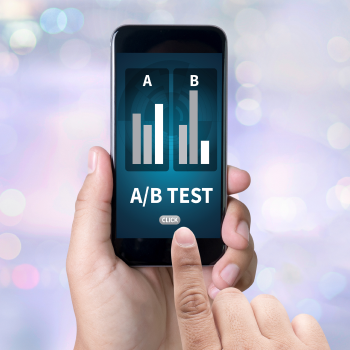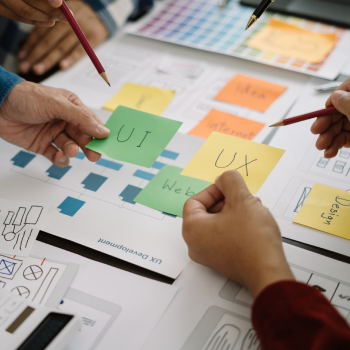Usability research and A/B testing
A very important element of designing digital products and websites is to provide users with the best possible experience. For this purpose, usability tests and A/B tests are used, among others.
... and how can we help you? Free consultation

Usability research is the process of analyzing how users interact with a given product or website. The main goal is to understand:
- how users use the product,
- what difficulties they encounter,
- what elements attract their attention and how they use them.
This research may include observations, interviews, performance testing, and other techniques to provide developers with feedback on what is working well and what may need improvement.
A/B testing is an experiment that compares two different versions of interface elements or content to determine which version performs better for a specific purpose.
For example, you can test two different website headlines to see which one attracts more clicks or conversions. Thanks to A/B testing, you can precisely determine which changes have a positive impact on user behavior and ultimately improve business results.
Benefits of analyzing user interactions
Analyzing user interactions brings many benefits to designers, creators and owners of websites or applications:
- Improve usability: Allows you to understand where users encounter difficulties when using your product, allowing you to make adjustments and create more intuitive interfaces.
- Conversion optimization: Interaction analysis helps identify places where users abandon their activity, e.g. abandoning a shopping cart. Thanks to this, you can take actions to increase conversions.
- Better adaptation to users: Understanding users' preferences and behaviors, which allows adapting the content, offer or functionality to their needs.
- Evidence of effectiveness: Interaction analysis provides measurable data that confirms the effectiveness of the changes introduced, which is particularly important in the context of making business decisions.
Identify places of decreased activity and increase conversions. Check what we can do for you.
Make an appointment for a consultation
Application in various industries
Usability research and A/B testing have universal applications in many industries:
 E-commerce: In online stores, interaction analysis helps improve the purchasing process and increase conversions by eliminating purchase barriers. Thanks to systematic A/B testing, e-commerce can quickly verify which solutions bring the best results, which allows for dynamic adaptation to changing customer preferences and needs.
E-commerce: In online stores, interaction analysis helps improve the purchasing process and increase conversions by eliminating purchase barriers. Thanks to systematic A/B testing, e-commerce can quickly verify which solutions bring the best results, which allows for dynamic adaptation to changing customer preferences and needs.

Medicine: In medical and health applications, interaction analysis can help create more intuitive tools and increase patient trust. Through systematic A/B testing, application developers can effectively evaluate various interface solutions and functionalities, adapting them to the needs and expectations of patients and medical staff.
![]() Banking: In the financial sector, usability research allows for the design of safe and convenient banking interfaces for mobile or web applications. Thanks to A/B testing and usability testing, banks can precisely assess the effectiveness of various interface elements, such as page layout, buttons, forms and payment processes.
Banking: In the financial sector, usability research allows for the design of safe and convenient banking interfaces for mobile or web applications. Thanks to A/B testing and usability testing, banks can precisely assess the effectiveness of various interface elements, such as page layout, buttons, forms and payment processes.
 Education: Appropriate design of interfaces and educational content based on interaction analysis can contribute to more effective knowledge acquisition, increasing motivation to learn and increasing the level of students' involvement in the educational process.
Education: Appropriate design of interfaces and educational content based on interaction analysis can contribute to more effective knowledge acquisition, increasing motivation to learn and increasing the level of students' involvement in the educational process.

Technology: In the case of software or electronic devices, interaction analysis is crucial to ensure ease of use and effectiveness, which impacts users by improving the user experience and increasing product acceptance in the market.
Usability research methods
In order to understand and improve the usability of a product or website, various usability research methods are used and can be applied depending on the specific goal and available resources:
- Observations
Allows you to directly monitor users as they use the product. This allows you to identify the problems and difficulties they face and observe their natural behavior.
- User interviews
Conduct interviews with users to gain a deeper understanding of their needs, expectations and opinions about the product. Interviews provide detailed information that may be more difficult to obtain through other methods.
- Surveys and Questionnaires
Introducing users to the product evaluation process through surveys or questionnaires allows for the collection of opinions from a larger number of people, although it may be less detailed than interviews.
- Task tests
They involve giving users specific tasks to perform in the product interface. This allows you to identify what difficulties they encounter when performing typical activities.
- Performance tests
They assess the speed and efficiency of the product, e.g. how quickly users find specific information or perform specific actions.
- Heat maps and usage data analysis
With analytical tools, you can track which areas of the interface are viewed most often, where users click and how long they stay on particular pages.
Free consultation
and check what usability tests we can perform for you.
The process of creating and implementing A/B tests
A/B testing is a continuous and iterative process. The key is to continually analyze data, experiment and make optimizations to achieve better business and user outcomes. What is the process of creating and implementing A/B tests?
- Goal definition: Define what goal you want to achieve with an A/B test. This could be increasing conversions, improving user interactions, increasing average time spent on the site, etc.
- Selecting Items for a Test: Select the specific items you want to compare. These may be, for example, headings, CTA (call-to-action) buttons, images or text content.
- Create variants: Create two different versions of selected elements. Option A (original) will serve as your reference and Option B will be the alternate version you want to test.
- Traffic Split: Split user traffic into two groups randomly. One group will see variant A and the other will see variant B. It is important that the division is random to avoid the influence of other variables.
- Test Implementation: Make changes to a live website or product. This could be by inserting JavaScript code or another tool that will allow different variants to be dynamically displayed for different users.
- Performance Monitoring: Track user behavior on both variants. Depending on the purpose of the test, it may include analysis of clicks, conversions, average time spent on the page, more sales, etc.
 A/B testing: Results analysis and optimization
A/B testing: Results analysis and optimization
After completing the A/B test, the next stage is to analyze the results and make decisions towards optimization. First, it is worth assessing the statistical reliability of the collected data to ensure that we have enough samples for reliable results.
The next step is to carefully compare the results achieved between variant A and variant B. In this context, it is important to define which variant achieved better results in terms of the established test objective.
However, analysis is not limited to numbers alone. It is also important to explore the reasons for any differences between the variants. This may include analyzing differences in content, layout, colors or emotions evoked by interface elements.
Based on these conclusions, substantive decisions can be made regarding further actions. The variant that performed better can be implemented as permanent design changes.
If the differences are not significant, you can perform further tests or look for other areas for optimization. Analysis of results and decisions made are a key process in improving products and implementing changes that bring real benefits to users and achieve intended business goals.
Free consultation
 When to use usability testing and when to use A/B testing?
When to use usability testing and when to use A/B testing?
Use usability research at the beginning of the design process when you want to understand how users use the product and identify their needs and problems. Usability testing is especially useful when you're planning significant changes to the interface that require a thorough understanding of user behavior.
You can use A/B testing when you have specific UI or content elements that you want to compare to determine which version performs better.
A/B testing is more appropriate when you already have some hypotheses or changes whose impact you want to measure in a more quantitative way.
Usability research and A/B testing – examples of application in practice
- E-commerce: After conducting usability tests, the shopping cart was identified as a source of abandonment. You can A/B test by comparing different cart and "Buy Now" button layouts to increase conversions.
- Mobile application: After usability tests, it turned out that users had difficulty navigating the application. A/B testing can involve comparing different menu layouts and navigation icons to increase ease of use.
- Website: Usability tests showed low effectiveness of the contact form. In A/B testing, you can test different form fields and messages to increase the number of form completions.
- Newsletter: After analyzing the data, it turned out that users rarely click on links in the newsletter. An A/B test may involve comparing two different versions of your content and link layout to increase your click-through rate.
In short, the integration of usability research and A/B testing enables a holistic approach to improving digital products. Usability testing helps understand the context and needs of users, and A/B testing allows you to measure the effectiveness of introduced changes and optimize the interface based on specific results.
What can we do for you?
At Ideo Software, we provide comprehensive support in the field of usability research and A/B testing, thanks to which your digital project will achieve better results and meet user expectations. Our services include:
- Professional analysis and strategy implementation: Thanks to our experts in the field of UX/UI and user research, we will conduct a detailed analysis of your product and propose optimization strategies based on solid research.
- Individual approach to each project: We understand that each project is unique. Therefore, we will approach your project individually, adapting our approach to your needs and goals.
- Use of the latest tools and technologies: As specialists in software development, we use the latest tools and technologies that will help in effective research and A/B testing.
- Support from experts with many years of experience: Our team consists of experienced experts in the field of interface design, user research and optimization who will be happy to help you achieve your goals.
No matter whether you need comprehensive user analysis, A/B testing or support in interface optimization - we are ready to meet your needs and provide effective solutions that will improve the quality of your product. Contact us together we will find a solution tailored to your business!
Contact us

 A/B testing: Results analysis and optimization
A/B testing: Results analysis and optimization When to use usability testing and when to use A/B testing?
When to use usability testing and when to use A/B testing?






